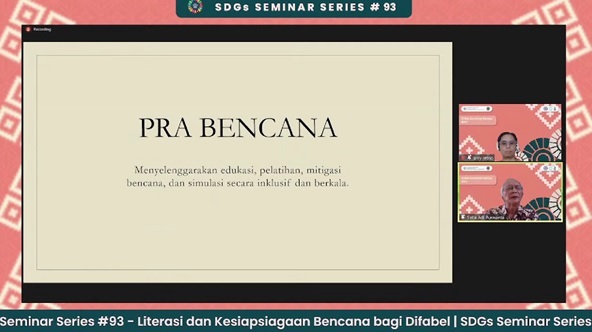
Disasters can strike anytime, so efforts to develop mitigation systems are crucial. However, vulnerable groups with physical, intellectual, mental, or sensory disabilities have not received special attention in this regard.
The UGM Faculty of Geography recently held a monthly SDGs discussion series entitled “Disaster Literacy and Preparedness for People with Disabilities” on Friday (September 29).
“We still need help and references from other countries as well. Because if we look at it, there have been many efforts in the context of disaster mitigation. But for people with disabilities, I see that there is still a lack of effort, which needs to be worked on together,” said the Secretary of UGM’s Council of Professors, Professor Baiquni.
“It is not excessive to say that Yogyakarta has great potential. Especially with extraordinary students, they can learn by accompanying groups of people with disabilities, such as mentoring, teaching, and introducing disaster management with actual maps.”
Yogyakarta is one area with a relatively high potential for disasters. In recent years, disasters such as earthquakes, landslides, and the threat of tsunamis have occurred. Even though there have been no casualties, the mitigation process still requires evaluation.
Professor Baiquni added one effort that could help people with disabilities understand the natural conditions in their area is through a guidebook.
“In the future, there will hopefully be a kind of guidebook that can be used for discussions. This guidebook will contain actual maps and specific guidelines for people with disabilities. So when something happens, they will understand what to do,” he added.
Fundamentally, disaster management phases must be carried out, ranging from preparedness to mitigation. Disaster management should no longer focus solely on emergency response after a disaster; rather, the focus should be on prevention.
“So, this must be directed towards pre-disaster management, not emergency response. In terms of responsibility, in the past, we saw disaster management as solely the government’s responsibility, but in the current paradigm, it is a shared responsibility. The same goes for threat management,” said Professor Chatarina Muryani, Head of the Disaster Study Center at Sebelas Maret University.
The urgency of disaster education has emerged in various national and international agendas. One strategy to improve the development of mitigation is through education.
Like other community groups, people with disabilities also need adequate disaster education. Therefore, providing disability needs in the education sector still needs to be promoted.
According to Setia Adi Purwanta, Executive Director of Griya Manunggal, regional governments have a significant role in establishing disaster service units for people with disabilities.
“First, there must be prioritization and inclusion. So, everyone is equal. Then, there is accessibility through appropriate accommodations,” Purwanta added.
“These accommodations are not only for people with disabilities but for anyone hindered in accessing information and movement. Because when a disaster occurs, the output is the same. It must be accurate and fast for everyone, even though their conditions are different. This is the main problem.”
Disaster management is an issue that intersects with many aspects of humanity. Disasters that can occur at any time have the potential to cause loss of life. Unfortunately, not all individuals have the same opportunity to access disaster information and emergency response.
Therefore, it is essential to emphasize the need to open access to vulnerable populations, such as people with disabilities.
Author: Tasya

